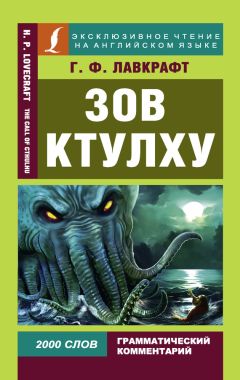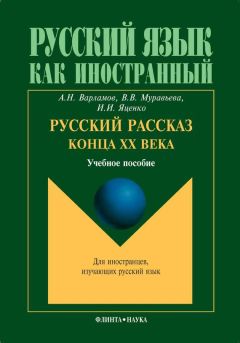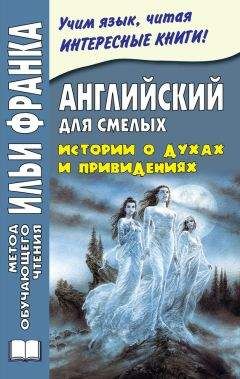Говард Лавкрафт - Зов Ктулху / The Call of Chulhu

Все авторские права соблюдены. Напишите нам, если Вы не согласны.
Описание книги "Зов Ктулху / The Call of Chulhu"
Описание и краткое содержание "Зов Ктулху / The Call of Chulhu" читать бесплатно онлайн.
Говард Филлипс Лавкрафт является одним из самых влиятельных писателей двадцатого века. Его произведения смешивают фантазию и научную фантастику с хоррором, открывая дверь в обширную, тёмную вселенную, полную невообразимых миров и существ. В истории, положившей ей начало, рассказывается о древней сущности, спящей на дне океана; сущности, желающей вырваться, чтобы подчинить себе жизнь на планете.
Тексты произведений сокращены и адаптированы, снабжены грамматическим комментарием и словарем, в который вошли ВСЕ слова, содержащиеся в текстах. Благодаря этому книга подойдет для любого уровня владения английским языком.
I suppose that only a single mountain-top, the hideous monolith-crowned citadel whereon great Cthulhu was buried, actually emerged from the waters. Johansen and his men were awed by the cosmic majesty of this dripping Babylon of elder demons, and probably guessed that it was nothing of this planet. Awe at the unbelievable size of the greenish stone blocks, at the height of the great carven monolith, and at the identity of the colossal statues and bas-reliefs with the queer image found in the shrine on the Alert, is visible in every line of the frightened description.
Johansen and his men landed at a sloping mud-bank on this monstrous Acropolis, and clambered slipperily up over titan oozy blocks. Even the sun seemed distorted.
It was Rodriguez the Portuguese[95] who climbed up the foot of the monolith and shouted of what he had found. The rest followed him, and looked curiously at the immense carved door with the squid-dragon bas-relief. It was, Johansen said, like a great barn-door; and they all felt that it was a door, though they could not decide whether it lay flat like a trap-door[96] or slantwise like an outside cellar-door. As Wilcox said, the geometry of the place was all wrong. One could not be sure that the sea and the ground were horizontal, because the relative position of everything else seemed phantasmally variable.
Briden pushed at the stone in several places without result. Then Donovan[97] studied the edge, pressing each point separately. He climbed along the grotesque stone moulding – and the men wondered how any door in the universe could be so vast. Then, very softly and slowly, the acre-great lintel began to go down; and they saw that it was balanced.
Everyone watched the queer recession of the monstrously carven portal. In this prismatic distortion it moved in a diagonal way.
The aperture was black. The odour rising from the newly opened depths was intolerable. Everyone listened, and everyone was listening still when It appeared and gropingly squeezed Its gelatinous green immensity through the black doorway into the tainted outside air of that poison city of madness.
Of the six men who never reached the ship, two died immediately. The Thing cannot be described – there is no language for such abysms of shrieking and immemorial lunacy, such contradictions of all matter, force, and cosmic order. A mountain walked or stumbled. God! What wonder[98] that across the earth a great architect went mad, and poor Wilcox raved with fever in that telepathic instant? The Thing of the idols, the green, sticky spawn of the stars, had awaked to claim his own.[99] The stars were right again, and what an age-old cult had failed to do, a band of innocent sailors had done by accident. After millions of years great Cthulhu was loose again, and ravening for delight.
Three men were swept up by the flabby claws before anybody turned. God rest them, if there be any rest in the universe. They were Donovan, Guerrera, and Angstrom.[100] Parker slipped as the other three were running to the boat, and Johansen swears he was swallowed up by masonry. When Briden and Johansen reached the boat, and pulled desperately for the Alert, the mountainous monstrosity flopped down the slimy stones and was floundering at the edge of the water.
Slowly, amidst the distorted horrors of that indescribable scene, the Alert began to sail; while on the masonry of that shore great Cthulhu slid greasily into the water and began to pursue. Briden looked back and went mad. He kept on laughing till death found him one night in the cabin while Johansen was wandering deliriously.
But Johansen had not surrendered. Knowing that the Thing could surely overtake the Alert, he set the engine for full speed, and reversed the wheel. The brave Norwegian drove his vessel head on against the pursuing jelly. Johansen drove on relentlessly.
There was a horrific bursting as of an exploding bladder, a stench as of a thousand opened graves, and a sound that the chronicler could not put on paper. For an instant the ship was hidden by an acrid green cloud, and – God in heaven![101] – the distance widened every second as the Alert gained impetus from its mounting steam.
That was all. After that Johansen only watched the idol in the cabin and prepared some food for himself and the laughing maniac. He did not try to navigate, for he was completely exhausted. Then came the storm of April 2nd, and he lost his consciousness.
One day came rescue – the Vigilant, the vice-admiralty court, the streets of Dunedin, and the long voyage back home to the old house. He could not tell – they would think him mad.[102] He wrote of what he knew before death came. Death would be a boon if only it could delete memories.
That was the document I read, and now I have placed it in the tin box beside the bas-relief and the papers of Professor Angell. This record of mine will be placed with them. I do not think my life will be long. As my uncle went, as poor Johansen went, so I shall go. I know too much, and the cult still lives.
Cthulhu still lives, too, I suppose, again in that chasm of stone which has shielded him since the sun was young. His accursed city is sunken once more, for the Vigilant sailed over the spot after the April storm; but his ministers on earth still bellow and prance and slay around idol-capped monoliths in lonely places. Who knows the end? What has risen may sink, and what has sunk may rise. It waits and dreams in the deep, and decay spreads over the tottering cities of men. A time will come – but I must not and cannot think about it! Let me pray that, if I do not survive this manuscript, my executors let nobody read this.
At the Mountains of Madness
I
I don’t want to tell my reasons for opposing the invasion of the Antarctic – with its vast fossil hunt and its melting of the ancient ice caps. I can understand clearly that my story will seem extravagant and incredible. But there are photographs, both ordinary and aerial, and they will count in my favor,[103] for they are vivid and graphic. Of course, some people can say that is all fakery. And there are ink drawings which can be jeered at as obvious impostures.
I must rely on the judgment and standing of the few scientific leaders who have, on the one hand, sufficient independence of thought; and on the other hand, sufficient influence to deter the exploring world in general from any over-ambitious program in the region of those mountains of madness. It is pity that ordinary men like myself and my colleagues, connected only with a small university, have little chance of making an impression.
In the strictest sense, we are not specialists in the fields concerned. Miskatonic University[104] sent me as a geologist. The aim of our expedition was to secure deep-level specimens of rock and soil from various parts of the Antarctic continent. We had a remarkable drill devised by Professor Frank H. Pabodie[105] of our engineering department. I had no wish to be a pioneer in any other field than this, but I hoped that the use of this new mechanical device would discover materials, unacceptable by the ordinary methods of collection.
Pabodie’s drilling apparatus was unique and radical in its lightness, portability, and capacity. Three sledges could carry steel head, jointed rods,[106] gasoline motor, collapsible wooden derrick,[107] dynamiting paraphernalia,[108] cords, rubbish-removal auger, and sectional piping for bores five inches wide and up to one thousand feet deep. This was possible due to aluminum alloy. Four large aeroplanes could transport our entire expedition from a base at the edge of the great ice barrier to various inland points.
We planned to explore a great area, operating mostly in the mountain ranges and on the plateau south of Ross Sea;[109] regions explored by Shackleton, Amundsen, Scott, and Byrd.[110] We expected to get a quite unprecedented amount of material – especially in the pre-Cambrian[111] strata. We wished also to obtain a variety of the upper fossiliferous rocks, since the primal life history of this realm of ice and death is of the highest importance to our knowledge of the earth’s past. The Antarctic continent was once temperate and even tropical; and we hoped to expand that information in variety, accuracy, and detail.
The public knows of the Miskatonic Expedition through our frequent reports to the Arkham Advertiser and Associated Press,[112] and through the later articles of Pabodie and myself. There were four men from the University – Pabodie, Lake[113] of the biology department, Atwood[114] of the physics department – also a meteorologist – and myself, representing geology – besides sixteen assistants: seven graduate students from Miskatonic and nine skilled mechanics. Of these sixteen, twelve were qualified aeroplane pilots, they were competent wireless operators as well. Eight of them understood navigation with compass and sextant, as did Pabodie, Atwood, and I. In addition, of course, our two ships were fully manned.[115]
The Nathaniel Derby Pickman Foundation[116] financed the expedition. The dogs, sledges, machines, camp materials, and unassembled parts of our five planes were delivered in Boston, and there our ships were loaded. We were marvelously well-equipped for our specific purposes. As the newspapers told, we sailed from Boston Harbor on September 2nd, 1930, taking a leisurely course down the coast and through the Panama Canal,[117] and stopping at Samoa and Hobart, Tasmania,[118] where we got final supplies. Our ship captains were J. B. Douglas,[119] commanding the brig Arkham, and Georg Thorfinnssen,[120] commanding the Miskatonic – both veteran whalers in Antarctic waters.
At about 62° South Latitude we noticed our first icebergs – table-like objects with vertical sides – and just before reaching the Antarctic circle,[121] which we crossed on October 20th with appropriately ceremonies, we were considerably troubled with field ice. The falling temperature bothered me considerably after our long voyage through the tropics. Very often the curious atmospheric effects enchanted me vastly; distant bergs became the battlements of unimaginable cosmic castles.
Pushing through the ice, we regained open water at South Latitude 67°, East Longitude 175°. On the morning of October 26th a snow-clad mountain chain appeared on the south. That was an outpost of the great unknown continent and its cryptic world of frozen death. These peaks were obviously the Admiralty Range discovered by Ross,[122] and our task was to round Cape Adare[123] and sail down the east coast of Victoria Land[124] to our base on the shore of McMurdo Sound,[125] at the foot of the volcano Erebus[126] in South Latitude 77° 9’.
The last part of the voyage was vivid and fancy-stirring. Great barren peaks of mystery, white snow, bluish ice and water lanes, and black bits of exposed granite slope. Something about the scene reminded me of the strange and disturbing Asian paintings of Nicholas Roerich,[127] and of the disturbing descriptions of the evil plateau of Leng[128] which appear in the dreaded Necronomicon of the mad Arab Abdul Alhazred. I was rather sorry, later on, that I had looked into that monstrous book at the college library.
On the 7th of November, we passed Franklin Island;[129] and the next day the cones of Mts. Erebus and Terror[130] on Ross Island appeared, with the long line of the Parry Mountains[131] beyond. There was a white line of the great ice barrier, rising perpendicularly to a height of two hundred feet like the rocky cliffs of Quebec, and marking the end of southward navigation. In the afternoon we entered McMurdo Sound and stood off the coast[132] near Mt. Erebus. Beyond it rose the white, ghostlike height of Mt. Terror, ten thousand, nine hundred feet in altitude.
One of the graduate assistants – a brilliant young fellow named Danforth[133] – noticed lava on the snowy slope. On the barren shore, and on the lofty ice barrier in the background, myriads of grotesque penguins walked.
Using small boats, we landed on Ross Island shortly after midnight on the morning of the 9th, preparing to unload supplies. Our camp on the frozen shore below the volcano’s slope was only a provisional one, headquarters were situated aboard the Arkham. We landed all our drilling apparatus, dogs, sledges, tents, provisions, gasoline tanks, experimental ice-melting outfit,[134] cameras, both ordinary and aerial, aeroplane parts, and other accessories, including three small portable wireless devices – besides those in the planes – capable of communicating with the Arkham’s large device from any part of the Antarctic continent that we would be likely to visit. The ship’s radio, communicating with the outside world, was able to convey press reports to the Arkham Advertiser’s powerful wireless station on Kingsport Head, Massachusetts.[135] We hoped to complete our work during an Antarctic summer; but if this became impossible, we would winter on the Arkham, sending the Miskatonic north for another summer’s supplies.
I need not repeat what the newspapers have already published about our early work. The health of our party – twenty men and fifty-five Alaskan sledge dogs – was remarkable, though of course we had not encountered really destructive temperatures or windstorms.
We had reached Beardmore Glacier,[136] the largest valley glacier in the world, and the frozen sea changed to a mountainous coast line. We were some eight thousand, five hundred feet above sea-level, and when experimental drillings revealed solid ground only twelve feet down through the snow and ice at certain points, we made considerable use of the small melting apparatus.
In certain of the sandstones we found some highly interesting fossil fragments; notably ferns, seaweeds, and mollusks – all this helps to study the region’s primordial history. There was also a queer triangular, striated marking, about a foot in greatest diameter. Lake, as a biologist, found these curious marking unusually puzzling and provocative, though to my geological eye it looked not unlike some of the ripple effects common in the sedimentary rocks. Since slate is no more than a metamorphic formation, I saw no reason for extreme wonder.
On January 6th, 1931, Lake, Pabodie, Danforth, the other six students, and myself flew directly over the South Pole in two planes, but there was a high wind. This was, as the papers have stated, one of several observation flights. Distant mountains floated in the sky as enchanted cities, and often the whole white world would dissolve into a gold, silver, and scarlet land of dreams under the magic of the low midnight sun.
Подписывайтесь на наши страницы в социальных сетях.
Будьте в курсе последних книжных новинок, комментируйте, обсуждайте. Мы ждём Вас!
Похожие книги на "Зов Ктулху / The Call of Chulhu"
Книги похожие на "Зов Ктулху / The Call of Chulhu" читать онлайн или скачать бесплатно полные версии.
Мы рекомендуем Вам зарегистрироваться либо войти на сайт под своим именем.
Отзывы о "Говард Лавкрафт - Зов Ктулху / The Call of Chulhu"
Отзывы читателей о книге "Зов Ктулху / The Call of Chulhu", комментарии и мнения людей о произведении.



























